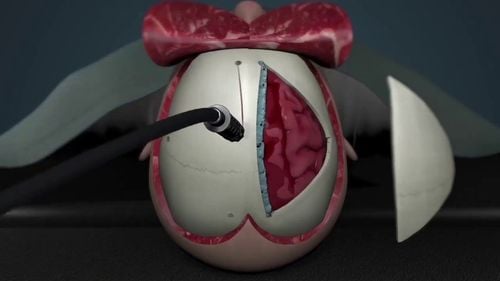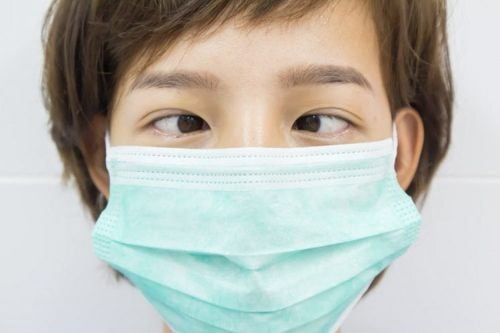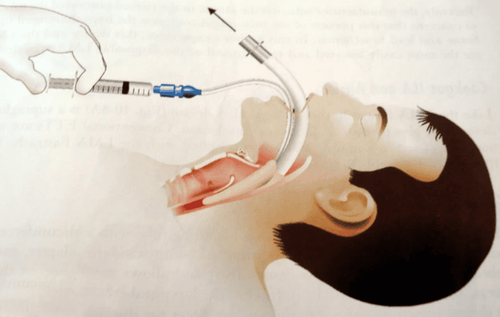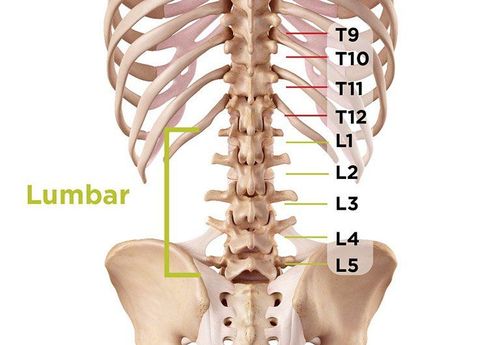This is an automatically translated article.
The article was professionally consulted with Specialist Doctor II Dinh Van Loc - Department of General Surgery - Vinmec Danang International General Hospital.In surgery for a submembranous abscess, the patient may be assigned to perform laryngeal mask anesthesia for the purpose of breathing control. This method of anesthesia has many advantages such as ease of implementation, high safety, few complications,...
1. What is laryngeal mask anesthesia?
1.1.What is Laryngeal Mask?Laryngeal mask was invented in 1981 by Dr. Archie Brain, and has been in use since 1988. Medicine is developing day by day and laryngeal mask has been improved many times on the basis of laryngeal mask. classic.
Laryngeal mask is a means of opening the upper airway, composed of a large barrel and an elliptical balloon at the lower end. Once placed and inflated, the balloon is closed with low pressure around the larynx entrance. Due to its convenience and nature, airway control is easier than with an endotracheal tube. Therefore, the laryngeal mask has been officially included in the difficult airway management regimen, especially in the situation where ventilation is not possible, intubation is not possible.
Second-generation laryngeal airway masks: LMA Pro-Seal, Supreme(LMA: Laryngeal mask airway) used more effectively and safely in the prone position: Avoiding gastric reflux and pressure higher cuff pressure compared to classic laryngeal masks
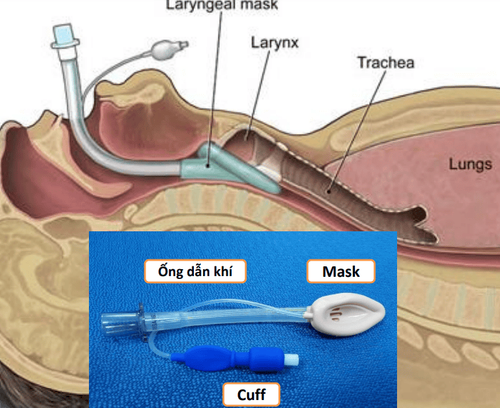
Advantages:
Using LMA Proseal, Supreme with the patient in prone position may be an acceptable alternative to intubation for selected patients. Reduced number of ancillary staff for positioning during surgical anesthesia, successful placement and ventilation, and low complication rate in prone patients. ProSeal LMA may offer benefits over other classical LMAs Enables rapid airway control, secures airway control in 95% of cases Ensures more hemodynamics as no position changes Less invasive Cough reflex, throat irritation compared with intubation Little or no sympathetic reflexes such as: Increased heart rate, increased blood pressure Reduced need for anesthetic, reduced incidence of sore throat. Cons:
Must ensure sufficient anesthesia Risk of reflux or aspiration 1.3. Placing a laryngeal mask in anaesthesia * Indications and contraindications
Indications for placing a laryngeal mask in anesthesia and resuscitation for the following cases:
Only anesthesiologists experienced with LMA can Using LMA for prone patients Moderate and short surgery, < 2 hours Outpatient surgery Contraindication to using laryngeal mask in anesthesia and resuscitation of prone patients in cases of:
Contraindication Exclusion criteria included limited mouth opening (distance between incisors < 20 mm), Mallampati Grade ≥3, Oropharyngeal disease, Body mass index ≥26 kg/m2, Lung disease and patients with risk of reflux. Spinal (neck) trauma
2. Technical details of laryngeal mask anesthesia in submeal abscess surgery
Laryngeal mask anesthesia is a technique of general anesthesia, which is performed to place a laryngeal mask for the purpose of controlling the airway during surgery for submembranous abscesses.2.1 Preparation before implementation
Implementation personnel: Doctors, nurses in the department of anesthesiology and resuscitation; Technical facilities: Anesthesia machine system with breathing, life function monitor, hand-held oxygen source, defibrillator, suction machine, laryngeal mask of all sizes, squeeze balloon, suction tube, oropharyngeal cannula, Salbutamol spray, Lidocaine 10% spray, means of prophylactic intubation (laryngoscope and endotracheal tube); Patients: Have an anesthetic examination before surgery to detect and prevent possible risks; the doctor explains the procedure in detail for the best cooperation; assess the possibility of difficult laryngeal mask placement and, if necessary, sedation from the night before surgery; Medical records: Prepare according to regulations.2.2 Carrying out anesthesia with laryngeal mask for submeal abscess surgery
Check records and patients, make sure the right person, the right disease; The prone position is used to operate on the back side of the body most commonly in spine surgery. General procedure: Put the patient in a prone position, with a head support device (against the patient's forehead), body lying prone on the table, two round pillows on both sides of the chest to expose the sternum, another round pillow at the hip level. , with good elasticity (usually made of foam padding) so that the patient's body does not rest on the table. Give 100% oxygen about 3 - 6 liters/min at least 5 minutes before induction of anesthesia, install a monitor, establish an effective infusion and give pre-anesthesia if necessary; Induction of anesthesia: Give the patient sleeping pills (including intravenous anesthetics, volatile anesthetics), analgesics, muscle relaxants if necessary. Eligible for laryngeal mask placement if the patient sleeps deeply and has sufficient muscle relaxation; Placing a laryngeal mask: Pro seal LMA (The ProSeal laryngeal mask airway (PLMA) + Place the patient in a supine position with the head and neck turned to the left. The transport trolley is placed along the operating table at a lower level. a little so that the patient can quickly lie on his back if the airway mask is not successful, hold the larynx mask, open the patient's mouth with one hand, the other hand put the larynx mask through the dental arches to the base of the tongue, push the mask Sliding along the hard palate into the hypopharynx;+ Stops when encountering obstacles;
+ Inflates the cuff according to the correct volume of each mask according to the instructions;
+ The exact position of the laryngeal mask is confirmed recognized by auscultation of clear bronchopulmonary sounds in both lungs and nasogastric tube placement. Check the tightness of the laryngeal mask (ensure no air leaks, easy ventilation) by listening to the lungs and evaluate based on the results of EtCO2; SPO2
+ Fix with adhesive tape;
Maintain anesthesia : + Maintain anesthesia with intravenous anesthetics, volatile anesthetics, analgesics and muscle relaxants if necessary;
+ Control breathing with an anesthetic ventilator
+ Monitor the depth of anesthesia through parameters of blood pressure, heart rate, sweating, lacrimation, MAC, BIS, Entropy,... ;
+ Monitor the patient's vital signs including blood pressure, heart rate, body temperature, SpO2 and EtCO2;
+ Preventing incorrect placement, retraction, folding or blockage of the laryngeal mask;
Criteria for removing the laryngeal mask: The patient is awake, can follow the doctor's orders, fully lift for more than 5 seconds, breathe spontaneously, breathing rate is within normal limits, body temperature is over 36°C, pulse and stable blood pressure, no complications of anesthesia and surgery.
2.3 Risk of complications and treatment measures
Implementation personnel: Doctors, nurses in the department of anesthesiology and resuscitation; Technical facilities: Anesthesia machine system with breathing, life function monitor, hand-held oxygen source, defibrillator, suction machine, laryngeal mask of all sizes, squeeze balloon, suction tube, oropharyngeal cannula, Salbutamol spray, Lidocaine 10% spray, means of prophylactic intubation (laryngoscope and endotracheal tube); Patients: Have an anesthetic examination before surgery to detect and prevent possible risks; the doctor explains the procedure in detail for the best cooperation; assess the possibility of difficult laryngeal mask placement and, if necessary, sedation from the night before surgery; Medical records: Prepare according to regulations.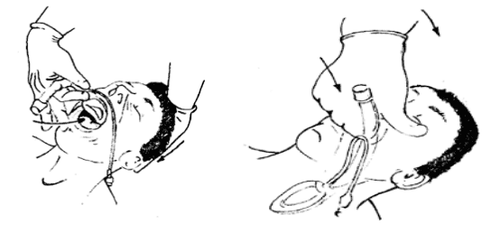
Vinmec International General Hospital is one of the hospitals that strictly applies safe surgical anesthesia practice standards according to international guidelines. With a team of experienced anesthesiologists and nurses, along with modern equipment such as nerve detectors, ultrasound machines, Karl Storz difficult airway control system, anesthesia monitoring system GE's comprehensive AoA (Adequate of Anesthesia) including monitoring of anesthesia, pain and muscle relaxation will deliver high quality and safety, helping patients to have adequate anesthesia, not awake, no residual relaxant muscle after surgery. Vinmec Health System is also proud to be the first hospital in Vietnam to sign with the World Anesthesiology Association (WFSA) towards the goal of becoming the safest hospital for surgical anesthesia in Southeast Asia.
Please dial HOTLINE for more information or register for an appointment HERE. Download MyVinmec app to make appointments faster and to manage your bookings easily.





